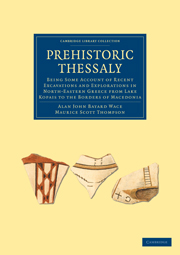 Prehistoric Thessaly
Prehistoric Thessaly Book contents
- Frontmatter
- PREFACE
- ABBREVIATIONS
- Contents
- LIST OF ILLUSTRATIONS
- INTRODUCTION
- CHAP. I THE GEOGRAPHY OF NORTH-EASTERN GREECE, AND THE DISTRIBUTION OF THE PREHISTORIC SITES
- CHAP. II THE PRINCIPAL CLASSES OF POTTERY AND CELTS
- CHAP. III NORTH THESSALY, RAKHMANI, MARMARIANI, MESIANI MAGHULA, ETC.
- CHAP. IV SOUTH EASTERN THESSALY, SESKLO, DHIMINI, PIRGHOS
- CHAP. V CENTRAL THESSALY, TSANGLI, RINI
- CHAP. VI WESTERN THESSALY, TSANI MAGHULA
- CHAP. VII SOUTHERN THESSALY, ZERELIA, PHTHIOTIC THEBES, ETC.
- CHAP. VIII THE SPERCHEUS VALLEY, LIANOKLADHI
- CHAP. IX BOEOTIA AND PHOCIS
- CHAP. X THE MYCENEAN PERIOD AND THE EARLY IRON AGE
- CHAP. XI ARCHITECTURE
- CHAP. XII CONNECTIONS WITH THE SOUTH
- CHAP. XIII CONNECTIONS WITH THE WEST
- CHAP. XIV CONNECTIONS WITH THE NORTH
- CHAP. XV CHRONOLOGY
- CHAP. XVI THE PREHISTORIC HISTORY OF NORTH-EASTERN GREECE
- CHAP. XVII ETHNOLOGICAL CONCLUSIONS
- APPENDIX I NOTES ON THE PREHISTORIC FINDS IN BULGARIA, ROUMANIA, ETC.
- APPENDIX II CHEMICAL ANALYSES, ETC.
- TABLE OF ILLUSTRATIONS REPRESENTING POTTERY
- MUSEOGRAPHICAL INDEX
- INDEX
- Plate section
CHAP. IV - SOUTH EASTERN THESSALY, SESKLO, DHIMINI, PIRGHOS
Published online by Cambridge University Press: 07 September 2011
- Frontmatter
- PREFACE
- ABBREVIATIONS
- Contents
- LIST OF ILLUSTRATIONS
- INTRODUCTION
- CHAP. I THE GEOGRAPHY OF NORTH-EASTERN GREECE, AND THE DISTRIBUTION OF THE PREHISTORIC SITES
- CHAP. II THE PRINCIPAL CLASSES OF POTTERY AND CELTS
- CHAP. III NORTH THESSALY, RAKHMANI, MARMARIANI, MESIANI MAGHULA, ETC.
- CHAP. IV SOUTH EASTERN THESSALY, SESKLO, DHIMINI, PIRGHOS
- CHAP. V CENTRAL THESSALY, TSANGLI, RINI
- CHAP. VI WESTERN THESSALY, TSANI MAGHULA
- CHAP. VII SOUTHERN THESSALY, ZERELIA, PHTHIOTIC THEBES, ETC.
- CHAP. VIII THE SPERCHEUS VALLEY, LIANOKLADHI
- CHAP. IX BOEOTIA AND PHOCIS
- CHAP. X THE MYCENEAN PERIOD AND THE EARLY IRON AGE
- CHAP. XI ARCHITECTURE
- CHAP. XII CONNECTIONS WITH THE SOUTH
- CHAP. XIII CONNECTIONS WITH THE WEST
- CHAP. XIV CONNECTIONS WITH THE NORTH
- CHAP. XV CHRONOLOGY
- CHAP. XVI THE PREHISTORIC HISTORY OF NORTH-EASTERN GREECE
- CHAP. XVII ETHNOLOGICAL CONCLUSIONS
- APPENDIX I NOTES ON THE PREHISTORIC FINDS IN BULGARIA, ROUMANIA, ETC.
- APPENDIX II CHEMICAL ANALYSES, ETC.
- TABLE OF ILLUSTRATIONS REPRESENTING POTTERY
- MUSEOGRAPHICAL INDEX
- INDEX
- Plate section
Summary
A. SESKLO
About an hour and a half north-west of Volos (Iolcus) amongst the hills, that border the plain on the west, in a small upland valley lies the village of Sesklo. At the lower end of this valley in the angle formed by the junction of two small torrents stands a mound (p. 8, no. 3) called Kastráki (Καστράκι). This mound was first noticed by Leake who conjectured that it might be the ancient Aesonia: a view afterwards accepted by Lolling, but rejected by Tsundas. The mound, which is of the high type, stands on a natural rise projecting like a cape between the two torrents, and is about 100 metres long and 45 broad. The prehistoric deposit varies from three to six metres in depth, and was excavated by Tsundas in 1901 and 1902. Remains of all the four prehistoric Thessalian periods were found, but here as on all Thessalian sites the change from period to period is gradual. That is to say there is no sharp line between any two periods or strata as at Lianokladhi, and the different classes of pottery overlap one another. The excavator divides the deposit of the First Period into three layers, the Second into two, and the Third and Fourth (regarded by him as one period) each consist of one layer.
Pottery
The pottery from Sesklo falls into four divisions corresponding with the four periods, into which the prehistoric remains of Thessaly can be divided.
- Type
- Chapter
- Information
- Prehistoric ThessalyBeing some Account of Recent Excavations and Explorations in North-Eastern Greece from Lake Kopais to the Borders of Macedonia, pp. 58 - 85Publisher: Cambridge University PressPrint publication year: 2010First published in: 1912
